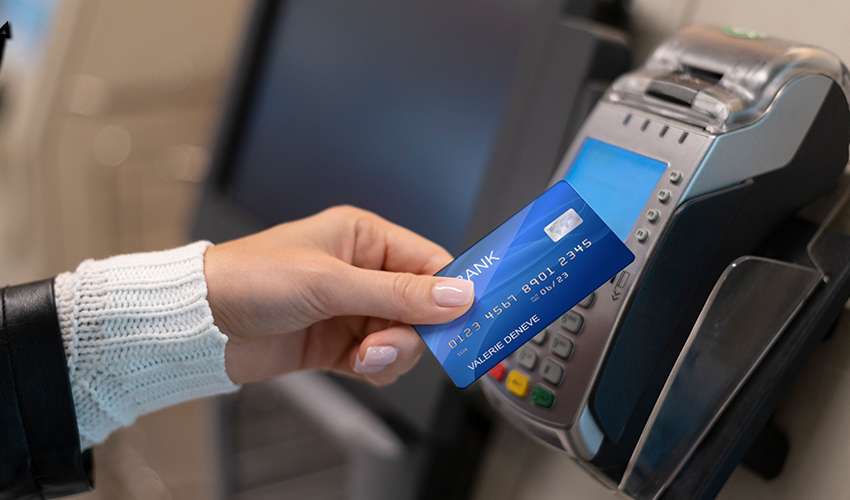Do you still need help to use the new EMV Chip Credit Cards? Fret not, in this blog, we will shed light on what EMV cards are and how to use a chip credit card correctly.
The economy is gradually transitioning from cash to plastic currencies. Nowadays, plastic currencies like credit and debit cards have become the norm and are slowly replacing cash. While credit and debit cards dominate our economy, EMV chip cards have gained traction as the global norm for credit card payments.
In recent years, the U.S. Credit card industry has evolved and moved to safer types of credit cards, also known as EMV cards. EMV stands for Europay, Mastercard, and Visa and it is a global standard for cards equipped with technology that is used to authenticate chip-card transactions.
Each credit card is integrated with small computer chips that store data and process transactions. EMV chips are now the standard in many new credit and debit cards and replace the previously used magnetic strip to provide additional security and protection. Nowadays, many merchants actually prefer EMV credit card transactions instead of the age-old method of swiping the card. This technology is very beneficial for data storage and makes transactions safe from cybercriminals.
Keep reading on to learn more about EMV chip cards and how to use a card with a chip.
- What are EMV Credit Cards?
- How Do EMV Credit Cards Work?
- How to Use a Chip Credit Card?
- EMV Cards Don’t Require a PIN
- Why Are EMV Cards Safer to Use?
- What if a Merchant Doesn’t Accept EMV Cards?
- Is Credit Card Fraud Still Possible with EMV Cards?
- What to Do If You Suspect Fraudulent Use of Your EMV Card?
- How to Protect Yourself from Credit Card Fraud?
- Final Words
- Frequently Asked Questions(FAQs)
What are EMV Credit Cards?
EMV stands for Europay, Mastercard, and Visa. It is a safer type of credit card that replaces the magnetic strip with an integrated metallic computer chip on your card. These cards store information on these metallic chips and can only be authenticated by special readers, making them more secure than their previous magnetic strip counterparts.
One of the best benefits of using an EMV credit card is that it offers enhanced protection against counterfeiting fraud. Counterfeit which was once quite common in which a cardholder’s information was stored, collected, and reprinted on another card, has seen a a steady decline since EMV chips were introduced.
The EMV chip ensures that every transaction is safe and is a modern and safe method for retailers and customers to exchange credit card information. If you make a transaction with an EMV credit card and the vendor does not support EMV chip card transitions, the bank’s responsibility for counterfeit fraudulent transactions is diverted to the vendor.
According to data from Visa, counterfeit fraud dropped 76$ between 2015 to 2018, among merchants and vendors who adopted the EMV chip cards.
How Do EMV Credit Cards Work?
For decades, credit cards saved your account numbers and other financial information on a magnetic strip on the back of your card. You essentially shared that information with a merchant whenever you swiped your credit card at the cash register at the time of purchase. However, it was very easy for cyber hackers and fraudsters to copy your account information from the magnetic strip and clone your card.
In the past decade, Europay, Mastercard, and Visa developed the EMV technology which which encrypts and stores your account information on a magnetic microchip embedded into your card, which made it harder to copy your data.
One of the primary benefits of an EMV credit card is protecting the cardholder’s information from fraudsters. The EMV Chips generate a one-time-use code to process the transactions instead of using the card number printed on the card.
Moreover, whenever you make a transaction with an EMV card, the merchant’s system doesn’t store or even receive your account information, protecting you in the event of a security breach. This makes it much harder for cyber hackers to counterfeit your card.
EMV chips simulate your card to make transactions. This process of simulating a card’s information is called tokenization. It is now a common method of securing sensitive system data. Contactless technologies like Google Pay, Apple Pay, and Samsung Pay also use the tokenization method to facilitate secure payments.
Read Also:- Credit Card vs. Debit Card: Which One to Choose?
How to Use a Chip Credit Card?
At the time of purchase, the primary difference between a magnetic strip card and an EVM card is the time the machine requires to read your card information. The new EVM technology is actually slower than magnetic strips. Instead of swiping your card or dunking it in and out, you insert your card into the reader and leave it for a few seconds.
Most restaurants also allow you to pay for the meal with a portable EMV card reader right at the table. This way, you won’t have to leave your card with the server to swipe it at the register. These systems are quite enhanced, also allowing you to add a tip after calculating it for you.
EVM credit card technology has an identical process to magnetic strip cards. You are required to swipe your card through an EVM card reader, the card processes your information and authorises the transaction. Here is a step-by-step guide to using an EVM credit card-
- Insert the card into an EVM card reader.
- The card reader locks the card and accesses the account information.
- On-screen instructions will be displayed to you.
- The card will be locked in the card reader until the whole process is complete.
- The card reader will generate a one-time-password
- Enter the password and complete the transaction.
While EMV transactions are secure and minimize the risk of fraudulent activities, EVM transactions are usually more time-consuming.
EMV Cards Don’t Require a PIN
EMV cards in the United States of America have moved primarily to chip and signature. However, many countries still use a chip and PIN version of the EMV cards. These cards use chip technology and also require the cardholder to enter a PIN to authenticate the transaction, similar to debit cards.
In 2018, the four major credit card issuers in the US- Visa, Mastercard, Discover, and American Express announced that they wouldn’t require any signatures for transactions. However, independent retailers may request them.
Some EMV credit cards in the USA still have a chip and PIN or a hybrid version of signature and PIN capabilities. With debit cards, cardholders have the option of entering their PINs to complete the transactions. They can also skip the PIN and sign the receipt to register it as a ‘credit’ transaction.
If you have a contactless card, a contactless symbol will be displayed on the front of the card. This allows the cardholder to simply tap the credit card on the card reader to complete the transaction.
However, one important thing to note is that using an EVM credit card outside of the USA is a different process. Using your EVM chip card in Europe or South America may require you to establish a PIN. Make sure to contact your credit card company before you travel and ensure to establish and generate a PIN when travelling to foreign countries.
As part of a contingency measure, always keep a backup card in place when travelling to another country in case your bank blocks your card for suspected fraud.
Read Also:- Best College Student Credit Cards of 2023
Why Are EMV Cards Safer to Use?
One of the primary benefits of using EMV cards is that reduces the risk of cybertheft and fraudulent activities. Moreover, they shift more liability towards the merchants. They are a lot safer than the traditional credit cards that store information on magnetic strips.
EMV credit cards contain a small computerized magnetic chip that creates a unique one-time-use code for each transaction and sends the code through the credit card system to authenticate the transaction.
After the code has been used, it can’t be used again. So, even if a cyber criminal gets access to this code, he can’t access your account information since the code has already been used once.
The magnetic chip technology greatly minimizes credit card cloning, assuming you always use EMV for transactions.
What if a Merchant Doesn’t Accept EMV Cards?
Even today, not all merchants accept EMV credit cards since some still don’t have any functional EMV readers installed. However, the number of merchants that accept EMV is also growing rapidly. VISA reported in March 2019 that over 75% of US stores accept EMV cards. The statistics went up from 50% just 2 years ago.
However, if your merchant doesn’t accept EMV cards, you can still swipe your card the old-fashioned way. Although this method is less secure, the merchant will be responsible for any fraudulent activities that arise from a swiped card. Most merchants have already installed EMV readers to avoid this liability.
Is Credit Card Fraud Still Possible with EMV Cards?
It is a known fact that EMV chip technology has significantly reduced credit card fraud. According to VISA, security chips on credit cards were responsible for reducing counterfeit fraud by 76% between 2015 and 2018 among merchants who used EMV card readers.
Moreover, in-person credit card fraud for no-chip payments and chip-authenticated payments dropped in the first year after EMVs were widely adopted across the United States of America. In 2016, EMV payments increased from 3.6% to 26.4%.
While most credit card terminals still support magnetic swiping as backup, swiped cards still run the same risk of counterfeiting and card cloning. Moreover, there is no alternative to physically stolen credit cards.
According to a survey of over 45,000 gas stations by ACI Worldwide, by April 27, 2021, only 8% of major fuel and convenience merchants had properly implemented EMV readers. This was after the deadline was extended several times for gas stations to comply with EMV automated fuel dispensers. Gas stations are one of the easiest places for credit card hackers to install credit card skimmers.
Online transactions also still carry the same amount of risk of fraud. Hackers are also getting better at phishing, effectively tricking you into sharing your credit card information by disguising themselves as a business person or government official. They may steal your data from where you have stored your credit card information for automated payments or one-click shopping. Ensure to be extra cautious when shopping online.
According to an analysis by EMVCo, the EMV chip card deployment and adoption rate was over 63% by the end of 2020. Moreover, most retailers have also installed EMV credit card readers at their establishments.
Read Also:- What Is the Annual Percentage Rate on Credit Cards?
What to Do If You Suspect Fraudulent Use of Your EMV Card?
If you suspect fraudulent use of your EMV card, fret not. All the same credit card fraud protection still applies to consumers of EMV cards. Credit card processing networks, credit card issuers, merchants, and merchant banks will decide which one of them is liable for fraudulent credit card transactions.
The credit card industry has also introduced ‘liability shift’ rules for fraudulent transactions which are supposed to be seamless for credit card holders. Cardholders are not liable for fraudulent purchases made while their credit card is in their possession and are only liable to a maximum of $50 liability on purchases made with a stolen card.
If you suspect fraudulent use of your credit card, contact your credit card issuer immediately by using the number on the back of your credit card. They will guide you on how to proceed.
How to Protect Yourself from Credit Card Fraud?
One of the best ways to protect yourself from credit card fraud is to always seek out merchants who accept EMV cards. However, if that's not available, you can also take some extra measures-
Be Extra Cautious When Shopping Online
While in-person counterfeit fraud is rapidly declining, credit card fraud has seemingly shifted to the web. Only enter your card details on websites that are secure and legitimate.
Don’t Share Your Card Number
Make sure to keep your card number to yourself and take all necessary precautions to keep it a secret. If you do need to share your card number with family members or trusted friends, make sure to get them added as authorized users with your credit card.
Check if Your Issuer Provides One-time-use Card Numbers
If your card issuer allows it, you may be able to tokenize your credit card number yourself. Cross-check with your issuer to find out if they provide single-use credit card numbers.
Regularly Check Your Card Statements and Credit Reports
Make sure to check your card statement regularly(at least once a month). According to the Credit Card Fraud Protection Terms and Conditions, you only have 60 days to report a fraudulent charge. Also, you are entitled to three free credit reports per year, make sure to take advantage of that.
Final Words
In conclusion, the whole point of EMV technology is to reduce fraud by integrating cards with magnetic computerized chips that are harder to replicate. Moreover, EMV cards also shift the liability for fraudulent activities to the merchants so consumers can take a sigh of relief.
However, this doesn’t mean that you are safe from credit card fraud. While in-person credit card fraud is on the decline, it has increased online. EMV chip technology does nothing to prevent online fraud, which is why it is our suggestion that you only enter your account information on websites that are legitimate and trustworthy.
Frequently Asked Questions(FAQs)
Ans. An EMV card is more secure as it provides a unique transaction code for each transaction that can only be used once. It is a special security feature that was not available in magnetic strip cards and the strips contained unchanging data. Whoever accesses that data, gains the financial information of the cardholder which can be misused by fraudsters.
Ans. Making transactions with your EMV card is fairly easy. Simply put your card into the EMV reader with the chip facing up and follow the directions displayed on the screen. Remove the card when prompted, sign for your purchase and take your receipt.
Similar to magnetic cards, EMV cards also process payment in two steps- card reading and transaction verification. However, EMV card transactions are relatively more time-consuming when compared to magnetic strip cards.
Ans. EMV cards are better than traditional magnetic strip cards as they provide plenty of benefits that were not available before. It is very difficult for hackers to clone an EMV card as compared to a magnetic strip card.
When you use your card at an EMV reader, the chip card technology prevents unauthorised usage of your card by generating a one-time password that can’t be used again for any purchases.








